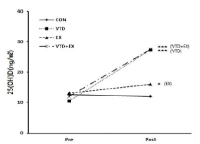Purpose The purpose of this study was to examine the effects of 16 weeks’ combined exercise training on insulin resistance, inflammatory markers, oxidative stress, leukocyte telomere length, body composition, and daily living fitness in elderly women with type 2 diabetes mellitus (DM). Methods Twenty-eight participants were randomly assigned into one of two groups, i.e., exercise training group (EX: n=14) and control group (CON: n=14). Subjects in EX participated in 3 sessions of 60 min-combined exercise for 16 weeks, whereas subjects in CON were asked to maintain their normal life pattern during the same period. The variables regarding insulin resistance, inflammatory markers, oxidative stress, leukocyte telomere length, body composition, and daily living fitness were measured and compared between two groups as well as between pre-post test utilizing a repeated two-way ANOVA. Results Main results were as follows: 1) Fasting plasma insulin and HOMA-IR tended to decrease in EX, whereas increased significantly in CON. 2) IL-6, TNF-α, hs-CRP decreased in EX, but the changes were not statistically significant. 3) MDA increased significantly and GPx decreased significantly in both EX and CON. 4) Leukocyte telomere length increased significantly in EX. 5) Fat-free mass increased in EX, whereas fat mass and percent body fat decreased significantly in EX. 6) Arm curl, chair stand, sit & reach, tandem test, 10m walking speed, and up & go improved significantly in EX. Conclusion It was concluded that the combined exercise for 16 weeks had a positive effect on improving insulin resistance, increasing leukocyte telomere length, as well as enhancing body composition and daily living fitness in elderly women with type 2 diabetes.
The purpose of this study was to investigate the effects of 8 weeks of aerobic training and resveratrol supplementation on a body composition, physical fitness, insulin resistance, liver function, blood pressure, and heart rate. Fifty-one elderly women were randomly assigned to aerobic training group (EX: n=12), resveratrol supplementation group (R: n=13), combined aerobic training and resveratrol supplementation group (EX+R: n=12), and control group (CON: n=14). The subjects in EX group exercised three sessions per week, 40 minutes per session for 8 weeks, the subjects in R group took 500 mg of resveratrol per day for 8 weeks, and the subjects in EX+R group received both treatments. The subjects in CON group were asked to maintain normal daily life pattern without any treatment for the same period of intervention. Body composition, physical fitness, insulin resistance, liver function, blood pressure, and heart rate were measured at pre- and post-test and the data were compared among groups and between tests by utilizing two-way ANOVA with repeated measures. Main results of the present study were as follows: 1) Physique and body composition did not change significantly in all groups. 2) Muscular endurance increased significantly in EX+R group, whereas the other physical fitness-related variables showed no significant changes in all groups. 3) Fasting glucose, fasting insulin, HOMA-IR, and HbA1c tended to be improved in EX+R group. 4) AST, ALT, and γ·GT showed no significant changes in all groups. 5) Systolic blood pressure and diastolic blood pressure increased significantly in CON group. Heart rate tended to be decreased in EX+R group and EX group. It was concluded that the 8 weeks of aerobic training and resveratrol supplementation had positive effects on muscular endurance, insulin resistance, and blood pressure in T2DM elderly women. Research investigating the effects of a longer period of aerobic training and resveratrol supplementation on the same variables would be warranted in the future.

The objective of this study was to investigate the effects of 12-weeks of vitamin D supplementation and circuit training on skeletal muscle mass in elderly women with type 2 diabetes mellitus and vitamin D deficiency. Forty eight elderly women with type-2 diabetes mellitus and vitamin D deficiency were randomly assigned to control(n=10), vitamin D supplement(n=11), exercise(n=12), and vitamin D supplement+exercise(n=15) groups. Dependent variables were measured before and after the 12-week interventions. Major outcomes included body composition, fasting glucose, insulin, and 25(OH)D concentration. ASM(apeendicular skeletal muscle mass), SMI(skeletal muscle mass), and HOMA-IR (homeostasis model for insulin resistance) were calculated. Women assigned to the vitamin D supplement consumed 1,200 IU of vitamin D orally per week for 12 weeks. Women assigned to the exercise intervention performed a circuit training at an intensity of 60%~80% of HRmax with a frequency of 3 days per week for 12 weeks. Compared to control group, all groups had significant loss of body weight and increases in serum 25(OH)D after the 12-week intervention. ASM and SMI increased significantly in only vitamin D+exercise group. Regardless of treatments, no significant group differences were found in changed scores of fasting glucose, insulin, and HOMA-IR. In conclusion, vitamin D + exercise would improve the loss of ASM and SMI compared with vitamin D or exercise alone.

